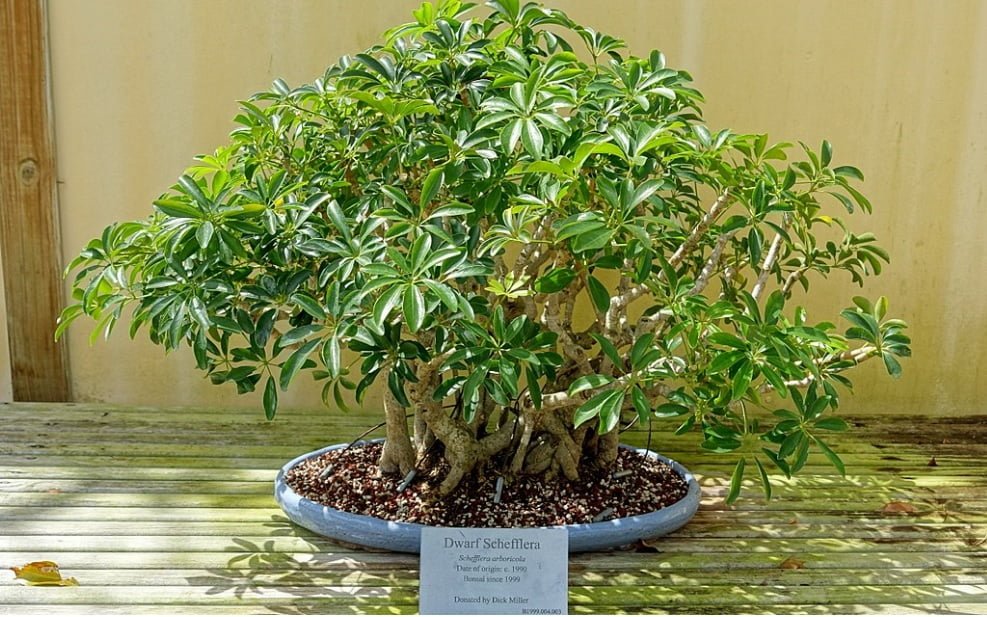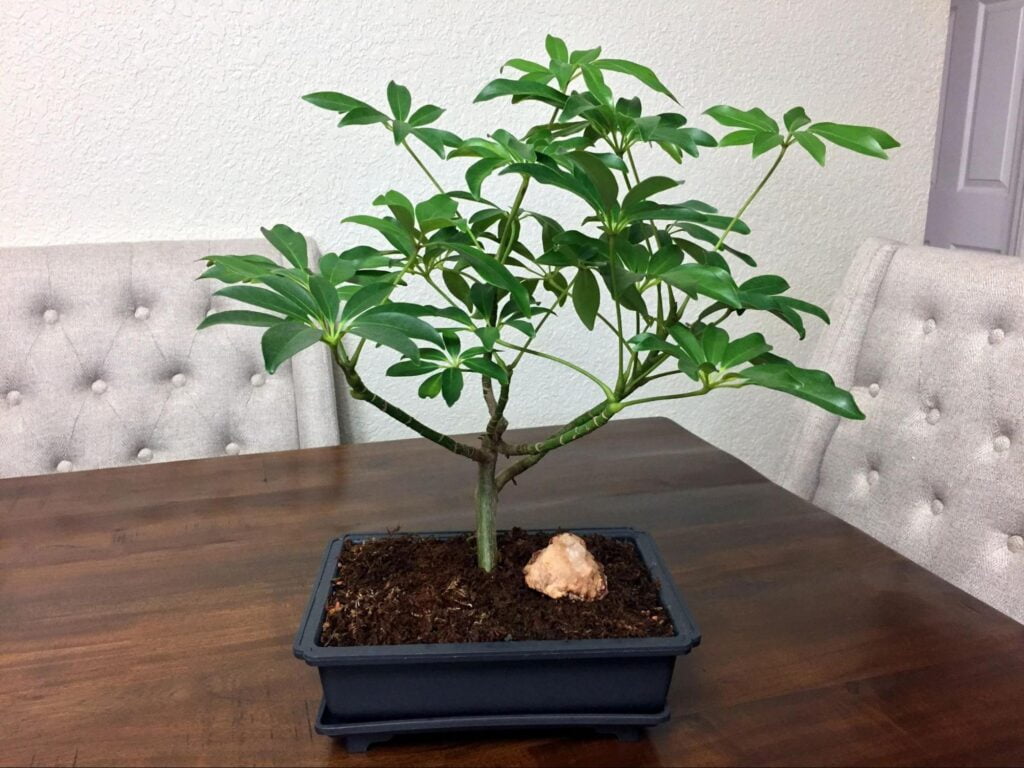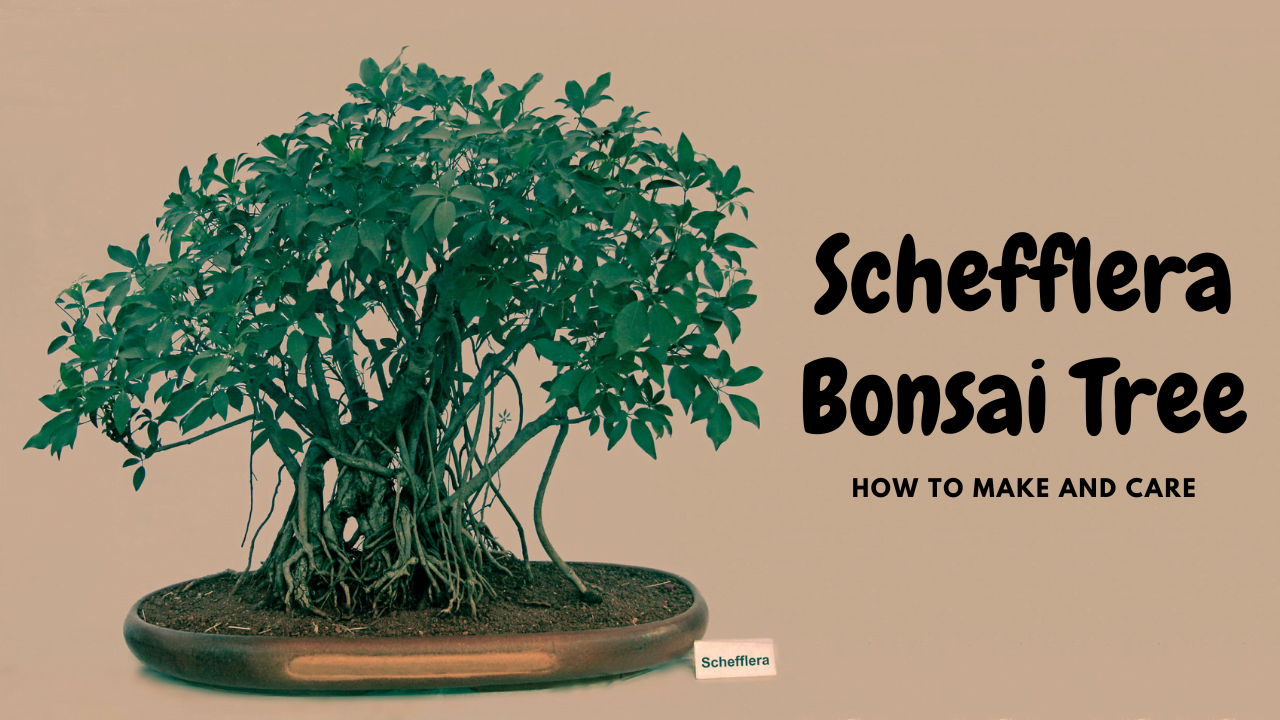If you are here to kick start your bonsai garden or planning to add a casual newbie to your terrace garden, then go for the Schefflera bonsai trees. The quick adaptability of the plants makes things easy, even if you are an absolute beginner!
Dwarf Schefflera bonsai trees exhibit perfect bonsai attributes with amazing rough trunks, branches and roots, which can easily grow indoors. In addition, its tolerance to low lighting and humidity makes it easier to grow indoors and beginner-friendly.
Dwarf Schefflera Bonsai Specification
| Botanical name | Schefflera arboricola |
| Common name | Dwarf Schefflera, Hawaiian umbrella tree, Dwarf umbrella bonsai |
| Description | The Azalea bonsai plants are native to Japan and belong to the hardy outdoor bonsai trees, mainly cultivated as bonsai for the tree-like look, abundantly bearing colourful flowers. |
| Height | 20 – 30 cm |
| Width | 8-12” |
| Sunlight | Tolerates dim lighting but grows fast and effectively when exposed to sunlight. |
| Watering | Water abundantly in summer until the soil is wet. Avoid watering until the soil is soggy, and reduce watering during the cold seasons. |
| Fertilizing | Fertilize twice a month during the growing seasons and once during winters. Use low nitrogen fertilizer if the scheffleras are grown indoors. |
| Pruning time | Defoliate and prune yearly until the plant naturally produces small leaves. Pruning can be altered after the plants mature for 2-4 years. |
| Repotting time | Replant the scheffleras every 2 year |
| Life span | 100+ years |
| Note | Develops radial leaves and aerial roots. A great option for root styling in bonsai. |
If you’re looking for a unique and beautiful addition to your outdoor space, an outdoor bonsai tree for sale is a great option. These miniature trees require special care and attention to thrive, but they offer many benefits, such as improving air quality and reducing stress. Many online and local retailers offer a variety of outdoor bonsai trees for sale, so shop around to find the perfect one for you.
How to make a Schefflera Bonsai

You can make a bonsai Schefflera bonsai tree from seed or through cuttings. Making a Schefflera tree from seed can be time-consuming as you have to wait until the plant matures and later train them into a bonsai. Using stem cutting methods, we only induce growth in an already grown plant, which is a relatively easy and quicker option.
To grow a Schefflera tree from seeds,
- Collect healthy Schefflera seeds from the nursery nearby and wash them
- Once cleaned, soak the seeds in a glass of water
- Collect the seeds that sink to the bottom of the glass and discard the floating seeds. Only viable seeds sink.
- Fill a container with soil and moisten them
- Sow the fertile seeds in a mixture of bonsai soil, peat moss and loam
- Cover and keep the container in a cold place
- After 2-3 months, transfer the soil to the sunny side of the garden to promote grow
- Later transfer the seedling to a training pot to train them into a bonsai.
Schefflera Bonsai Care
Taking care of a bonsai tree is all about consistency and patience. Regular watering and fertilizing can grow the plant, but you must work to maintain its structure and appearance. In addition, using styling methods to train your plant into bonsai takes time.
Schefflera bonsai trees are relatively easy as you can worry less about lighting. Read more as we discuss the aspects and requirements to care for the dwarf Schefflera bonsai trees successfully.
Placement

Bonsai plants need light to survive, which accelerates new growth and results in smaller leaves. Depending on these requirements, we decide if the plant needs to be indoors or outdoors.
The Schefflera bonsai trees can tolerate low lighting and humidity. It can be grown indoors with minimal lighting. You should take care to provide an ideal temperature of 65° F to 72° F / 18° C to 22° C. During winters, close the windows if they are placed indoors; you must protect them from frost. The plant is delicate to cold temperatures. Avoid leaving the plant at a temperature below 50° F / 10° C
When given direct sunlight, the plant grows fast and effectively. You can notice smaller and glossy leaves grown outdoors or with abundant lighting. They can also survive reasonably in dim lighting, though the leaves will remain big and reduce plant growth.
Watering
When watering the bonsai plant pot, there is only one main rule. First, you pour water gradually until the excess water seeps through the bottom hole in the plant pot. Then, it is done to ensure that adequate water reaches all parts of the soil.
Never let the bonsai soil dry out completely. Instead, check for moisture and keep the soil damp. At the same time, avoid overwatering the plants; this makes the soil soggy and spreads root diseases.
It would be best if you did not go over hydrate the plant during winters, as the lack of heat and sunlight can cause infections. If the Schefflera bonsai tree is grown indoors, you can try bottom watering during winter. When the plant bottom and roots are over hydrated, they might lead to diseases like root rots.
Temperature:
Schefflera is a tropical plant and requires tropical temperatures for healthy growth. So temperatures below 60 degrees Fahrenheit will be extremely low for them to survive. Sililerly it will suffer if the weather is constantly dry. Schefflera loves high levels of humidity, so never ever put your plant near dry heating vents. An underwatered or freezing Schefflera bonsai tree will start to fall its leaves fast, so take leaf-drop seriously and fix the matter if it happens. If the plant drops all of its leaves, you can try to rescue the bonsai by repositioning it outside in the spring and watering generously.
Fertilizing

Feeding the dwarf Schefflera bonsai is vital to encourage growth and maintain its size. Depending on its environmental conditions and level of growth, we decide the quantity and frequency of fertilization.
If your plant is outdoors enjoying abundant light, then use more fertilizers, as more growth is in the outdoor plants. You can use organic bonsai fertilizers from the market twice a month during the summers and once a month during winter. If it is a liquid fertilizer, opt for a weekly routine to feed the Schefflera bonsai trees. To avoid stress on the plants, dilute the liquid fertilizer to half its strength.
If you grow Schefflera bonsai trees indoors, reduce the number of fertilizers you use. As the plants are already growing slowly indoors, with dim lighting, the addition of fertilizers will only increase the stress on the roots. As a result, you might burn the roots or even kill these dwarf planets.
It is also suggested to use fertilizers with a low nitrogen ratio and more phosphorus and potassium. Too much nitrogen in the roots can induce more growth and makes the leaves large and leathery. It spoils the appearance of the dwarf Schefflera bonsai tree. Some leaves might even turn yellow and develop brown tips, eventually dying after a while.
Pruning Schefflera Bonsai
The leaves and branches have a natural tendency to grow upwards and outwards. While caring for a bonsai, they need to control these plant parts from spreading wider; hence they are trained. You can do training by pruning or trimming the leaves and branches to cut the growing process and shape the bonsai plants.
How to prune schefflera bonsai trees
You can completely defoliate a healthy Schefflera bonsai tree to encourage new growth. While defoliating, you can also remove the tips of the new plant growth. Doing so ensures the leaves grow in the lower parts of the branch.
When you trim the new branches on the tip of the canopy, new branches grow below, making them look bushier and dense. You can also trim unnecessary and dead branches during the process.
If not pruned regularly, the plant might overgrow its size and produce large and broader leaves. It also grows randomly and eventually loses stability. These are potential branches to shape the branches trim ½ inch above the buds in the leaf node. Once trimmed, these buds grow into the desired branch.
In the dwarf, Schefflera bonsai pruning is done every year until the desired shape is achieved, and after that, you can reduce pruning to once in 2-4 years.
Wiring

Schefflera are shaped using wires. Shaping is done to maintain the appearance of the bonsai plant and control the growth in the desired direction. Doing so ensures the plant stays a bonsai yet appears fully grown.
The stems and branches of Scheffleras are brittle and delicate. When you wind them, once they are matured, you might break them. The best time is to wire them when they are still young and flexible. Wind the training wire gently around the stems and gradually bend them to the desired shape every week.
Mature leaves are also wired. Young leaves die when wired, as they are gentle and fragile. Do not wind the wire too tightly. Leave space for future growth in the plant. Over tight wires can cause scarring, though fortunately, the scarring in the leaves can be removed when they die.
Start winding the wire from the stem and go up to its petiole. Let the leaflets stay untouched. Then, after a month or so, cut the wires and let the plant grow. By now, they would have adapted to the shape.
Repotting
As the plant grows, it will absorb soil fertility and deplete it. To provide fresh nutrients and soil, we do repotting. It is usually done once every 2 or 3 years and is mandatory for all bonsai plants to stay healthy.
Schefflera are no different and require regular care. Once every 2 or 3 years, replant the plant to fertilizer rich soil. Carefully pick the roots from the soil and wash them clean. Remove all the dirt and old soil from the tips. Avoid damaging the roots by harsh handling or while picking them. Make a trench around the plant to remove the root from the soil.
Check for dead and infectious roots; cut these completely. You can also trim the primary roots up to 10% of their overall growth. Avoid damaging the roots by harsh handling or while picking them. Instead, use chopsticks or wooden dowels to handle the roots delicately.
Choose the correct pot to replant the dwarf Schefflera bonsai trees. The pot size is recommended to be two-thirds of the canopy’s size. You assure to maintain visual balance in the plant’s canopy and its base. Appropriate pot size also checks on maintaining the ideal moisture level in the soil.
Propagation

Schefflera can be propagated through seeds and cuttings. If there is the ready availability of mature plants, then propagate through cuttings. It is easy, effective, and productive compared to the seed propagation method.
You can place the cut stem in damp soil and seal the container to propagate through the stems. After 4- 6 weeks, the roots will appear. Now is the perfect time to pick the cutting with roots from the container and transfer them to the training pot.
Over-watering the soil or rotten stems cannot develop roots and eventually die.
Pests and diseases
Schefflera mostly stays pest-free. Though occasionally, it can develop scales. In such cases, please treat them with oil-based insecticides. Use one tablespoon of dormant oil per gallon of water, and spray them weekly for a month or two. The spraying will control scale infestation when uniformly sprayed on all parts of the plants.
Common issues with the Schefflera bonsai plant?
This bonsai species is low maintenance and resilient to almost all circumstances, but sometimes they can also face some issues, which are;
Yellowing Leaves:
Overwatering is usually the reason why your Schefflera’s leaves turn yellow. Try watering in smaller portions to see if the plant improves its appearance. If not, your bonsai might not be acquiring sufficient sunlight so place it in a brighter area.
Brown Spots on Leaves:
Underwatering is potentially the reason behind the spots on your Schefflera bonsai. In that case, water your plants more frequently during the growing season, and give them a good and thorough drink. The best approach is to water the bonsai deeply and let the soil dry out before giving it another deep watering.
FAQs
Is the Schefflera bonsai plant toxic?
The Schefflera plant’s juice has calcium oxalate crystals, which can provoke nominal skin irritation if you come in touch with the leaves. You may want to wear gloves to stop irritation when operating the bonsai. Swallowing the Schefflera bonsai leaves is not advisable, as it can cause vomiting, mouth numbness, and additional side effects.
The Schefflera bonsai tree is poisonous to dogs and cats. Symptoms that your pet might have consumed the plant are mouth, lip, and tongue itch, excessive drooling, problems in swallowing, and frequent throwing up. If you eat the plant or doubt your pet has done so, please get in touch with a medical expert.
How long do Schefflera bonsai plants live?
Outdoor Scheffleras extended in the right hardiness zones can live for years; indoor bonsai plants can live for 25 years or longer, relying on the kind of care it’s receiving.
Is Schefflera bonsai a lucky plant?
The Schefflera bonsai has been considered to harbor good fortune, but this may be because of its cluster-shaped foliage, which looks like hands. With this lovely formation, you are certain to create a positive environment.
Conclusion
Growing and caring for the dwarf Schefflera bonsai tree is relatively easy. It can be a great option if you don’t own an open terrace or an outdoor garden; your window sills are great for starting these bonsai babies. Here is your best chance to begin a bonsai garden if you are a beginner. However, if you are an enthusiast with minimal effort, taking care of the bonsai, Schefflera can be a piece of cake.
Related Articles
- Propagating Chinese Elm Bonsai Cuttings And From Seeds
- Best Chinese Elm Bonsai Soil and Fertilizer.
- Troubleshooting Common Problems With Chinese Elm Bonsai
- Buy Chinese Elm Bonsai: How Not to Get Scammed When Purchasing a Chinese Elm Bonsai Tree!
- Chinese Elm Bonsai Pruning And Styling.
- Creating a Chinese Elm Bonsai Forest- Step-By-Step Guide.

